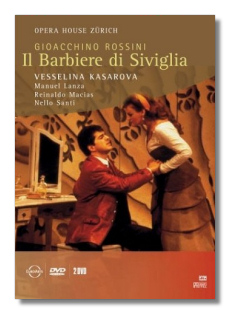
The Internet's Premier Classical Music Source
Related Links
- Rossini Reviews
- Latest Reviews
- More Reviews
-
By Composer
-
Collections
DVD & Blu-ray
Books
Concert Reviews
Articles/Interviews
Software
Audio
Search Amazon
Recommended Links
Site News
 DVD Review
DVD Review
Gioachino Rossini

The Barber of Seville
- Vesselina Kasarova (Rosina)
- Manuel Lanza (Figaro)
- Reinaldo Macias (Count Almaviva)
- Carlos Chausson (Bartolo)
- Nicolai Ghiaurov (Basilio)
Orchestra & Chorus of the Opera House Zürich/Nello Santi
TDK EuroArts DVD 205124 9 (Naxos) Widescreen, Dolby, DTS Surround Sound 2DVDs 147:00
A "firework display of exhilarating comedy" was how one newspaper described this Barber of Seville from the Zürich Opera, enthusing about the "unforced liveliness" of the cast. But it also praised the efforts of Grischa Asagaroff, director of this new production, to avoid routine slapstick and to give special attention to the characters' psychological situations. His idea of transporting the action to Spain in the early 20th century proved a remarkably effective basis for this undertaking, purging the work of all rococo quaintness while retaining its Mediterranean flair and the charms of a subtle patina. This performance was conducted by Nello Santi, who animated his orchestra to play with both precision and verve, and who missed not a single point or dab of color in the score. The cast was led by Manuel Lanza as Figaro, Reinaldo Macias as the Count, Carlos Chausson as Bartolo and Nicolai Ghiaurov as Basilio. However, the show really belongs to Vesselina Kasarova's colorful Rosina who, according to the Neue Zurcher Zeitung, "turned this Barber into a major event."
Taken from a live performance at the Zürich Opera House in April, 2001, this performance is an extremely impressive account of this opera, Rossini's most popular and certainly among his finest. Bulgarian mezzo Vesselina Kasarova has been a part of this Zürich production since 1996, though other cast members have changed over the years. She is the centerpiece here, delivering a most charming Rosina. But the other principals aren't exactly left in the dust, with Carlos Chausson and Reinaldo Macias turning in especially fine work. Veteran Nicolai Ghiaurov is an excellent Basilio, too, and ageless conductor Nello Santi leads the ensemble with a knowing baton, his players responding with great spirit.
The whole production is colorful, although there may be some viewers taken aback by its 20th century setting. Figaro, for example, drives around a motor cycle with side car, and it would seem the action takes place sometime in the first half of the 20th century, though the costumes can sometimes suggest an 18th- or 19th-century setting, as well.
The sound is excellent, and this recording must be considered strong competition for the other DVD issues of The Barber of Seville, which include the Gabriele Ferro-led performance, with Cecilia Bartoli (also on EuroArts), and Abbado's DG effort (from 1974), with Teresa Berganza. This new EuroArts issue, then, is highly recommended.
Copyright © 2004, Robert Cummings


















